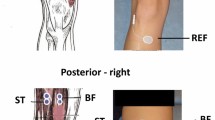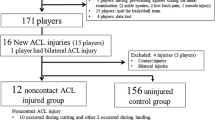Abstract
Background
This prospective study aimed to investigate the relationship between static balance and the incidence of non-contact anterior cruciate ligament (ACL) injury in female high school athletes.
Methods
This study included 276 female high school handball or basketball players. At the time of admission, each subject’s static balance was measured with a gravicorder, and the incidence of non-contact ACL injury was investigated in the 3 years until the student graduated. The measured parameters of postural sway were locus length per time (the distance that a center of gravity of the foot pressure moves per second) and environmental area (AR: the area surrounded by the integumentary covering of the trace of the center of gravity). Twenty-seven players (9.8%) experienced an ACL injury during the 3-year observation period. Twenty-four injured players sustained a non-contact injury and three injured players sustained a contact injury. In this study, the three contact injury players were excluded. We compared the differences in the static balance between injured and uninjured players.
Results
The locus length per time was significantly longer in injured than in uninjured players (p = 0.046). Though there was no statistically significant difference between the two groups in AR (p = 0.190), AR tended to be larger in the ACL injured group.
Conclusions
This result shows that poor static balance is a risk factor for non-contact ACL injury.


Similar content being viewed by others
References
Agel J, Olson DE, Dick R, Arendt EA, Marshall SW, Sikka RS (2007) Descriptive epidemiology of collegiate women’s basketball injuries: National Collegiate Athletic Association Injury Surveillance System, 1988–1989 through 2003–2004. J Athl Train 42:202–210
Ajuied A, Wong F, Smith C, Norris M, Earnshaw P, Back D, Davies A (2014) Anterior cruciate ligament injury and radiologic progression of knee osteoarthritis: a systematic review and meta-analysis. Am J Sports Med 42(9):2242–2252
Alentorn-Geli E, Myer GD, Silvers HJ, Samitier G, Romero D, Lázaro-Haro C, Cugat R (2009) Prevention of non-contact anterior cruciate ligament injuries in soccer players. Part 1: mechanisms of injury and underlying risk factors. Knee Surg Sports Traumatol Arthrosc 17:705–729
Cerulli G, Benoit DL, Lamontagne M, Caraffa A, Liti A (2003) In vivo anterior cruciate ligament strain behaviour during a rapid deceleration movement: case report. Knee Surg Sports Traumatol Arthrosc 11:307–311
Chalmers PN, Mall NA, Moric M, Sherman SL, Paletta GP, Cole BJ, Bach BR Jr (2014) Does ACL reconstruction alter natural history? A systematic literature review of long-term outcomes. J Bone Jt Surg Am 96(4):292–300
Claiborne TL, Armstrong CW, Gandhi V, Pincivero DM (2006) Relationship between hip and knee strength and knee valgus during a single leg squat. J Appl Biomech 22:41–50
Daneshjoo A, Mokhtar AH, Rahnama N, Yusof A (2012) The effects of comprehensive warm-up programs on proprioception, static and dynamic balance on male soccer players. PLoS One 7:e51568. https://doi.org/10.1371/journal.pone.0051568
Demura S, Yamaji S, Noda M, Kitabayashi T, Nagasawa Y (2001) Examination of parameters evaluating the center of foot pressure in static standing posture from viewpoints of trial-to-trial reliability and interrelationships among parameters. Equilib Res 60:44–55
Dick R, Lincoln AE, Agel J, Carter EA, Marshall SW, Hinton RY (2007) Descriptive epidemiology of collegiate women’s lacrosse injuries: National Collegiate Athletic Association Injury Surveillance System, 1988–1989 through 2003–2004. J Athl Train 42:262–269
Dyhre-Poulsen P, Krogsgaard MR (2000) Muscular reflexes elicited by electrical stimulation of the anterior cruciate ligament in humans. J Appl Physiol 89:2191–2195
Emery CA, Cassidy JD, Klassen TP, Rosychuk RJ, Rowe BH (2005) Effectiveness of a home-based balance-training program in reducing sports-related injuries among healthy adolescents: a cluster randomized controlled trial. CMAJ 172:749–754
Garrick JG, Requa RK (2001) Anterior cruciate ligament injuries in men and women: how common are they? In: Griffin LY (ed) Prevention of noncontact ACL injuries. American Academy of Orthopaedic Surgeons, Rosemont, pp 1–9
Griffin LY, Albohm MJ, Arendt EA, Bahr R, Beynnon BD, Demaio M et al (2006) Understanding and preventing noncontact anterior cruciate ligament injuries. Am J Sports Med 34:1512–1532
Imai A, Kaneoka K, Okubo Y, Shiraki H (2014) Effects of two types of trunk exercises on balance and athletic performance in youth soccer players. Int J Sports Phys Ther 9:47–57
Imaoka K, Murase H, Fukuhara M (1997) Collection of data for healthy subjects in stabilometry. Equilib Res Suppl 12:1–84
Ishii Y, Noguchi H, Takeda M, Sato J, Kishimoto Y, Toyabe S (2013) Changes of body balance before and after total knee arthroplasty in patients who suffered from bilateral knee osteoarthritis. J Orthop Sci 18:727–732
Kitabayashi T, Shinichi D, Masahiro N (2003) Examination of the factor structure of center of foot pressure movement and cross-validity. J Physiol Anthropol Appl Hum Sci 22:265–272
Koga H, Nakamae A, Shima Y, Iwasa J, Myklebust G, Engebretsen L, Bahr R, Krosshaug T (2010) Mechanisms for noncontact anterior cruciate ligament injuries: knee joint kinematics in 10 injury situations from female team handball and basketball. Am J Sports Med 38:2218–2225
Leetun DT, Ireland ML, Willson JD, Ballantyne BT, Davis IM (2004) Core stability measures as risk factors for lower extremity injury in athletes. Med Sci Sports Exerc 36:926–934
Mehl J, Diermeier T, Herbst E, Imhoff AB, Stoffels T, Zantop T, Petersen W, Achtnich A (2018) Evidence-based concepts for prevention of knee and ACL injuries. 2017 guidelines of the ligament committee of the German Knee Society (DKG). Arch Orthop Trauma Surg 138:51–61
Morris C (1992) Academic Press dictionary of science and technology. Academic Press Inc, San Diego
Okuda K, Abe N, Katayama Y, Senda M, Kuroda T, Inoue H (2005) Effect of vision on postural sway in anterior cruciate ligament injured knees. J Orthop Sci 10:277–283
Olsen OE, Myklebust G, Engebretsen L, Bahr R (2004) Injury mechanisms for anterior cruciate ligament injuries in team handball: a systematic video analysis. Am J Sports Med 32:1002–1012
Olsen OE, Myklebust G, Engebretsen L, Holme I, Bahr R (2005) Exercises to prevent lower limb injuries in youth sports: cluster randomised controlled trial. BMJ 330:449. https://doi.org/10.1136/bmj.38330.632801.8F.
Palmieri-Smith RM, Wojtys EM, Ashton-Miller JA (2008) Association between preparatory muscle activation and peak valgus knee angle. J Electromyogr Kinesiol 18:973–979
Petersen W, Braun C, Bock W, Schmidt K, Weimann A, Drescher W, Eiling E, Stange R, Fuchs T, Hedderich J, Zantop T (2005) A controlled prospective case control study of a prevention training program in female team handball players: the German experience. Arch Orthop Trauma Surg 125:614–621
Prodromos CC, Han Y, Rogowski J, Joyce B, Shi K (2007) A meta-analysis of the incidence of anterior cruciate ligament tears as a function of gender, sport, and a knee injury—reduction regimen. Arthroscopy 23:1320–1325
Shumway-Cook A, Woollacott MH (2003) Controle postural normal. In: Shumway-Cook A, Woollacott MH (eds) Controle motor. teorias e aplicações práticas, 2nd edn. Barueri, Manole, pp 53–178
Simoneau GG, Ulbrecht JS, Derr JA, Becker MB, Cavanagh PR (1994) Postural instability in patients with diabetic sensory neuropathy. Diabetes Care 17:1411–1421
Smith HC, Vacek P, Johnson RJ, Slauterbeck JR, Hashemi J, Shultz S, Beynnon BD (2012) Risk factors for anterior cruciate ligament injury: a review of the literature—part 1: neuromuscular and anatomic risk. Sports Health 4:69–78
Solomonow M, Krogsgaard M (2001) Sensorimotor control of knee stability. A review. Scand J Med Sci Sports 11:64–80
Vrbanić TS, Ravlić-Gulan J, Gulan G, Matovinović D (2007) Balance index score as a predictive factor for lower sports results or anterior cruciate ligament knee injuries in Croatian female athletes-preliminary study. Coll Antropol 31:253–258
Waddington GS, Adams RD (2004) The effect of a 5-week wobble-board exercise intervention on ability to discriminate different degrees of ankle inversion, barefoot and wearing shoes: a study in healthy elderly. J Am Geriatr Soc 52:573–576
Wester JU, Jespersen SM, Nielsen KD, Neumann L (1996) Wobble board training after partial sprains of the lateral ligaments of the ankle: a prospective randomized study. J Orthop Sports Phys Ther 23:332–336
Zhou S, McKenna MJ, Lawson DL, Morrison WE, Fairweather I (1996) Effects of fatigue and sprint training on electromechanical delay of knee extensor muscles. Eur J Appl Physiol Occup Physiol 72:410–416
Acknowledgements
The authors wish to acknowledge all the high school female athletes for their participation in this study. We also thank the members of the project group who significantly contributed to the data collection and study discussion.
Funding
There is no funding source.
Author information
Authors and Affiliations
Contributions
Conceptualization: Katsuhiko Kitaoka, Yosuke Shima. Project administration and Supervision: Hiroyuki Tsuchiya. Investigation, Formal analysis and Validation: Takeshi Oshima, Junsuke Nakase, Hitoaki Numata, Yasushi Takata. Writing-original draft: Takeshi Oshima. Writing-review and editing: Hiroyuki Tsuchiya, Junsuke Nakase.
Corresponding author
Ethics declarations
Conflict of interest
The authors declare that they have no conflict of interest.
Ethical approval
This study was approved by the ethics committee of Kanazawa University (approval number: 1050).
Rights and permissions
About this article
Cite this article
Oshima, T., Nakase, J., Kitaoka, K. et al. Poor static balance is a risk factor for non-contact anterior cruciate ligament injury. Arch Orthop Trauma Surg 138, 1713–1718 (2018). https://doi.org/10.1007/s00402-018-2984-z
Received:
Published:
Issue Date:
DOI: https://doi.org/10.1007/s00402-018-2984-z




